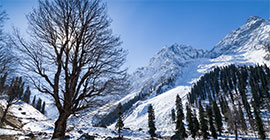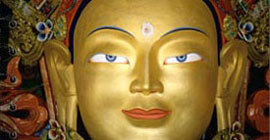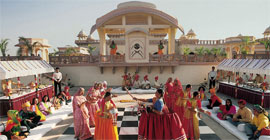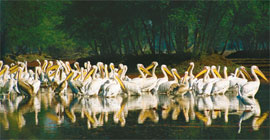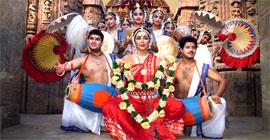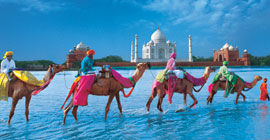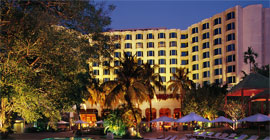Bodhgaya
Home | Bodhgaya
Gautama Buddha's attainment of nirvana (Enlightenment).
Historically, it was known as the Bodhimanda (ground around the Bodhi-tree), Uruvela, Sambodhi, Vajrasana and Mahabodhi. The name Bodhgaya did not come into use until the 18th century. The main monastery of Bodhgaya used to be called the Bodhimanda-vihara (Pali). Now it is called the Mahabodhi Temple.
For Buddhists, Bodhgaya is the most important of the main four pilgrimage sites related to the life of Gautama Buddha, the other three being Kushinagar, Lumbini, and Sarnath. In 2002, Mahabodhi Temple, located in Bodhgaya, became a UNESCO World Heritage Site.
History
A small temple beneath the Bodhi tree, Bodhgaya, built in 7th century, after the original built by King Ashoka in 3rd century BC, ca. 1810
Offerings found in Bodhgaya under the "Enlightenment Throne of the Buddha", with a decorated coin of the Kushan emperor Huvishka, 3rd century CE. According to Buddhist traditions, circa 500 BC Prince Gautama Siddhartha, wandering as a monk, reached the sylvan banks of Falgu River, near the city of Gaya. There he sat in mation under a bodhi tree (Ficus religiosa). After three days and three nights of mation, Siddharta attained enlightenment and insight, and the answers that he had sought. He then spent seven weeks at seven different spots in the vicinity mating and considering his experience. After seven weeks, he travelled to Sarnath, where he began teaching Buddhism.
Disciples of Gautama Siddhartha began to visit the place where he had gained enlightenment during the full moon in the month of Vaisakh (April-May), as per the Hindu calendar. Over time, the place became known as Bodhgaya, the day of enlightenment as Buddha Purnima, and the tree as the Bodhi Tree.
The history of Bodhgaya is documented by many inscriptions and pilgrimage accounts. Foremost among these are the accounts of the Chinese pilgrims Faxian in the 5th century and Xuanzang in the 7th century. The area was at the heart of a Buddhist civilization for centuries, until it was conquered by Turkish armies in the 13th century.
Mahabodhi Temple
The temple stands in the east to the Bodhi Tree. Its architectural effect is superb. Its basement is 48 square feet and it rises in the form of a slender Pyramid till it reaches its neck, which is cylindrical in shape. The total height of the temple is 170 ft. and on the top of the temple are Chatras which symbolize sovereignty of religion. Four towers on its corners rise gracefully giving the holy structure a poise balance. This sacred edifice is like a grand banner unfurled by time to proclaim to the world the pious efforts of the Buddha to solve the knots of human miseries, to ascend above worldly problems and to attain transcendental peace through wisdom, good conduct and disciplined life.
Inside the temple, in the main sanctum, there is a colossal image of the Buddha in sitting posture touching the earth by his right hand. In this posture the Buddha accomplished the supreme enlightenment. The statue is of black stone but it has been guilder by the devotees. The entire courtyard of the temple is studded with large number of votive stupas. These stupas are of all sizes built during the past 2500 years ago. Most of them are extremely elegant in structural beauty. The ancient railings, which surround the temple, are of the first century BC and are among the very interesting monuments of the century.
Animesh Lochan Chaitya: It is believed that the Buddha spent one week here looking towards the great Bodhi tree out of gratitude, without twinkling his eyes.
Bodhi Tree: The present Bodhi Tree is probably the fifth succession of the original tree under which the Buddha had attained enlightenment. Vajrasana, the seat of stability, is a stone platform on which the Buddha is supposed to have sat in meditation gazing east, under the Bodhi tree.
Chankramana: This marks the sacred spot of the Buddha's meditative perambulations during the third week after pious enlightenment. It is believed that wherever the Buddha put his feet lotus sprang up.
Ratnagarh: The Buddha spent one week here, where it is believed that five colors came out of his body.
Thai Temple
Other Treasures of Bodhgaya: 80 ft Statue of the Buddha, Lotus Tank, Buddha Kund, Rajayatana, Brahm Yoni, Chinese Temple & Monastery, Burmese Temple, Buddhist Monastery of Bhutan, International Buddhist House & Japanese Temple, Thai Temple & Monastery, Tibetan Monastery, Archaeological Museum. Sujata village (2 kms), Dungeshwari Hill (Prag bodhi) (22 kms by road), Maitraya Project (3 kms).







